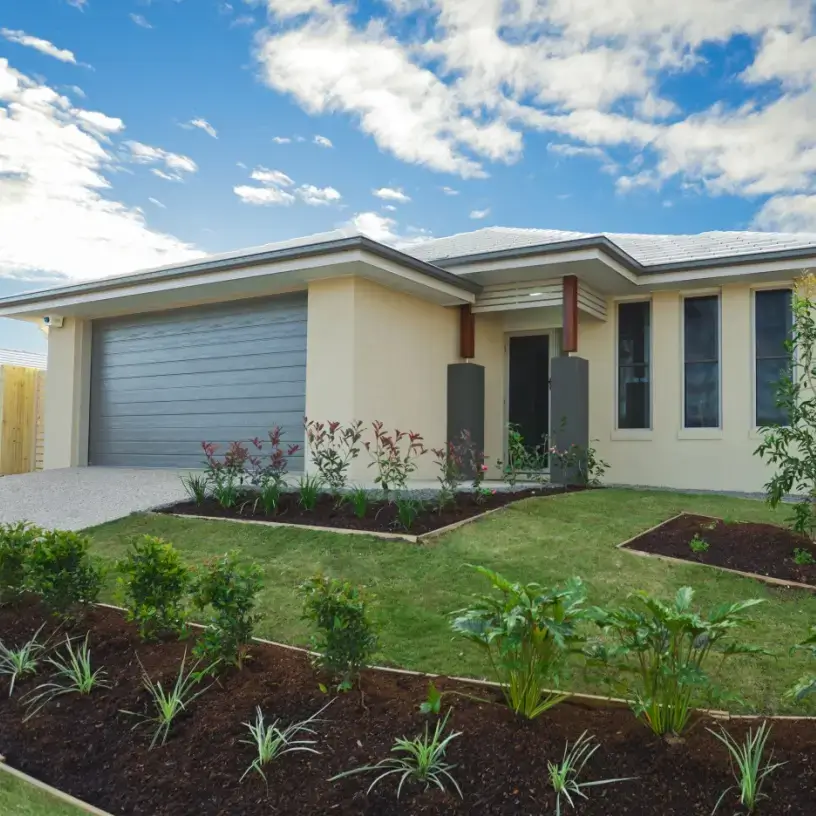Home / Compare Home And Content… / New home insurance
New home insurance
A guide for purchasing home insurance for new builds






Key takeaways
- There’s no specific ‘new home insurance’ policy, but a variety of home and contents products could cover your new house.
- Damages from fire, storms and vandalism are just a few things that are typically covered by home and contents insurance.
- Your builder’s insurance policy should cover your home while it’s being built.
- Some lenders may require you to purchase home insurance to secure your home loan.
- Reviewing your policy annually could help you avoid underinsurance.
Expert tips for getting the most from your home insurance policy
Our resident home and contents insurance expert, Adrian Taylor, has helpful tips for those looking to insure their new home.

Get an estimate for an insured value
If you’re unsure about how much to insure your property for, you could use an online building sum insured calculator could help you decide. Don’t forget to regularly review and update your insured sum to avoid underinsurance.
Consider flood and accidental damage cover
Cover for floods or accidental damage may not be included in your standard home insurance policy. If they aren’t, these can often be added. Even though you’ll pay extra, these benefits could be worth adding for peace of mind.
Always be honest with your insurance provider
To help avoid disappointment, make sure you’re honest in the information you provide to your insurer and let them know of any change in your circumstances, as this can affect both your premium and any potential claims.
Types of insurance for new homes
Home building insurance
Home building insurance typically covers damage to the walls, roof and floors of your insured address, as well as the kitchen and bathroom fixtures and fittings.
Contents insurance
Contents insurance can insure against the repair or replacement costs of the furniture, clothing, possessions and décor you bring into your new home. If your home is an apartment, townhouse or otherwise part of a larger building or complex, contents insurance may be the only policy you need to have.
Home and contents insurance
A combined home and contents policy insures both the home building and your possessions inside it.
Inclusions and exclusions
What items can home and contents insurance cover?
It depends on your insurer and the type of cover. The table below outlines some common items that are covered by home and contents insurance policies.
| Home insurance | Contents insurance |
|---|---|
|
|
What does home and contents insurance cover?
Home and contents insurance can cover your new home for loss or damage caused by a variety of insured events. The table below offers an overview of what’s typically covered by the different home insurance types.
| Insured event | Home insurance | Contents insurance | Home and contents insurance |
|---|---|---|---|
| ✓ | ✓ | ✓ | |
| Fire damage | ✓ | ✓ | ✓ |
| Flood damage | ✓/Optional extra | ✓/Optional extra | ✓/Optional extra |
| Earthquake | ✓ | ✓ | ✓ |
| Movement of the sea | ✗ | ✗ | ✗ |
| Vandalism | ✓ | ✓ | ✓ |
| Theft | ✓ | ✓ | ✓ |
| Impact damage (excluding deliberate damage) | ✓ | ✓ | ✓ |
| Portable contents | ✗ | Optional extra | Optional extra |
| Motor burnout | Optional extra | Optional extra | Optional extra |
| Damage from vermin (including rodents and insects) | ✗ | ✗ | ✗ |
| War and uprising | ✗ | ✗ | ✗ |
| Accidental damage | Optional extra | Optional extra | Optional extra |
| Escape of liquid (excluding the leaking item, e.g. burst pipe) | ✓ | ✓ | ✓ |
| Removing debris | ✓ | ✓ | ✓ |
| Damage from renovations | ✗ | ✗ | ✗ |
| Temporary accommodation | ✓ | ✓ | ✓ |
Cover is subject to limits, sub-limits and exclusions. Always read the relevant Product Disclosure Statement (PDS) before you purchase a policy. The Target Market Determination (TMD) can also help you figure out if an insurance product is suitable for your circumstances.
What are some common home and contents insurance exclusions?
Some common home and contents insurance exclusions may include damages from:
- General wear and tear
- Business activities (unless specified in your policy)
- Leaving your home vacant for an extended period without notifying your insurer
- Renovations or building extensions
- Home swapping
- Structural defects or faults
- Pets and animals
- Hydrostatic pressure
- Terrorism, nuclear contamination and acts of war
- Actions of the sea (e.g. king tides, storm surges)
- Landslide or subsidence (unless caused by an insured event)
- Mould
- Tree lopping or roots at your home
- Illegal activities and fraudulent acts.
- Deliberate actions.
Ensure you read the key facts sheet contained within your policy’s PDS so you understand exactly what’s included and excluded from your cover.
Getting adequate cover
How much should I insure my home for?
 There are several factors to consider when deciding how much to insure your home for, including:
There are several factors to consider when deciding how much to insure your home for, including:
- Your home’s size, ground slope, design, features, materials and any permanent features like timber floors, patios and carports.
- Internal fittings and fixtures such as taps and faucets, kitchen cupboards, vanity units, light fittings, floor tiles and linoleum.
- Structural improvements, like in-ground swimming pools, awnings, pergolas, decks, fencing and tennis courts.
Your home insurance should be enough to completely repair or replace your home and its outbuildings. However, when calculating the value of your home, remember to exclude the land value.
How much should I insure my contents for?
When determining the value of your contents for insurance, think about how much it would cost to replace all your possessions and valuable items. These items may include:
- Clothing and footwear
- Appliances and furniture
- Electronics
- Rugs and curtains
- Crockery and valuables.
While your contents insurance will typically cover your belongings in your home, items you take outside your home (like mobile phones, laptops and wedding rings) may need portable contents cover. This is typically offered as an optional extra, which you can add to your standard contents insurance policy for an extra cost.
What’s the difference between sum insured and total replacement cover?
Sum insured cover reimburses you for losses or damages up to a set limit nominated by you (i.e. your sum insured). Total replacement cover provides financial protection to restore your home to its original condition before the event that caused the damage.
What is underinsurance?
Underinsurance is when you don’t have enough insurance coverage to fully pay for the cost of repairing, replacing or rebuilding your insured home and contents. This can happen if you set the sum insured too low or you haven’t updated your policy in a while.
If you’re underinsured, your claim payout could be insufficient to compensate for the expenses needed for a rebuild, meaning you might have to foot the remainder of the bill.
Home insurance premiums
How much does home and contents insurance cost?
The cost of home and contents insurance for your new home will depend on your insurer and level of cover, as well as factors unique to you like:
- The sum insured of your home and belongings
- The age, structure and building materials of your home
- The age of the policyholder
- Your claims history
- The location of the home
- Your home’s security features
- If you add optional cover to the policy (e.g. accidental damage or personal effects cover)
- The policy excess
- Government charges, taxes or levies relating to your policy.
If you want to get a better idea of how much it might cost to insure your home and contents, you can compare quotes from a range of insurers with our free comparison tool.
Can I pay my insurance premiums in instalments?
Yes, you can generally choose to pay your insurance premiums for your new home in fortnightly or monthly instalments. Keep in mind that paying premiums in instalments may cost more than an annual payment in the long run since they’ll be subject to processing fees.
Purchasing cover for different scenarios
Can I get home insurance for a new build while it’s under construction?
The construction company should have insurance for the work they undertake while the home is being built. This should include insurance for builders and sub-contractors to cover damages if something goes wrong during construction.
Once your home is built, you can purchase home and contents insurance for your new home before you move in.
Can I get home insurance for an investment property?
Investment homes can be covered by landlord insurance. This cover is similar to regular home insurance but includes benefits specific to landlords, such as theft and malicious damages by tenants and their guests.
You can also purchase contents cover if you have removable furnishings in your investment home.
If I live in a strata property, can I still get home and contents insurance?
As a strata resident, you’ll typically only need to get contents insurance to cover your belongings, whether you own the property or rent it. Strata property owners typically pay body corporate fees, which usually go towards insurance to cover the physical structure of the whole complex, plus the common areas.
You may be able to get building cover for a strata property if you live in a standalone home (e.g. a villa).
Do I need home insurance before settlement?
To secure your home loan, some lenders may require you to take out a policy to cover the property you’re buying. Should your new home be damaged or destroyed, having cover for repair or rebuild costs could prevent a significant financial loss to both you and your lender.
Meet our home and contents expert, Adrian Taylor
As a General Insurance expert with over 13 years’ experience in financial services, Adrian Taylor works to make it easier for homeowners, renters and landlords to protect their home and contents. He believes it’s important for all residents (whether they rent, own or lease) to have adequate financial cover for their property and belongings in case the worse should happen.